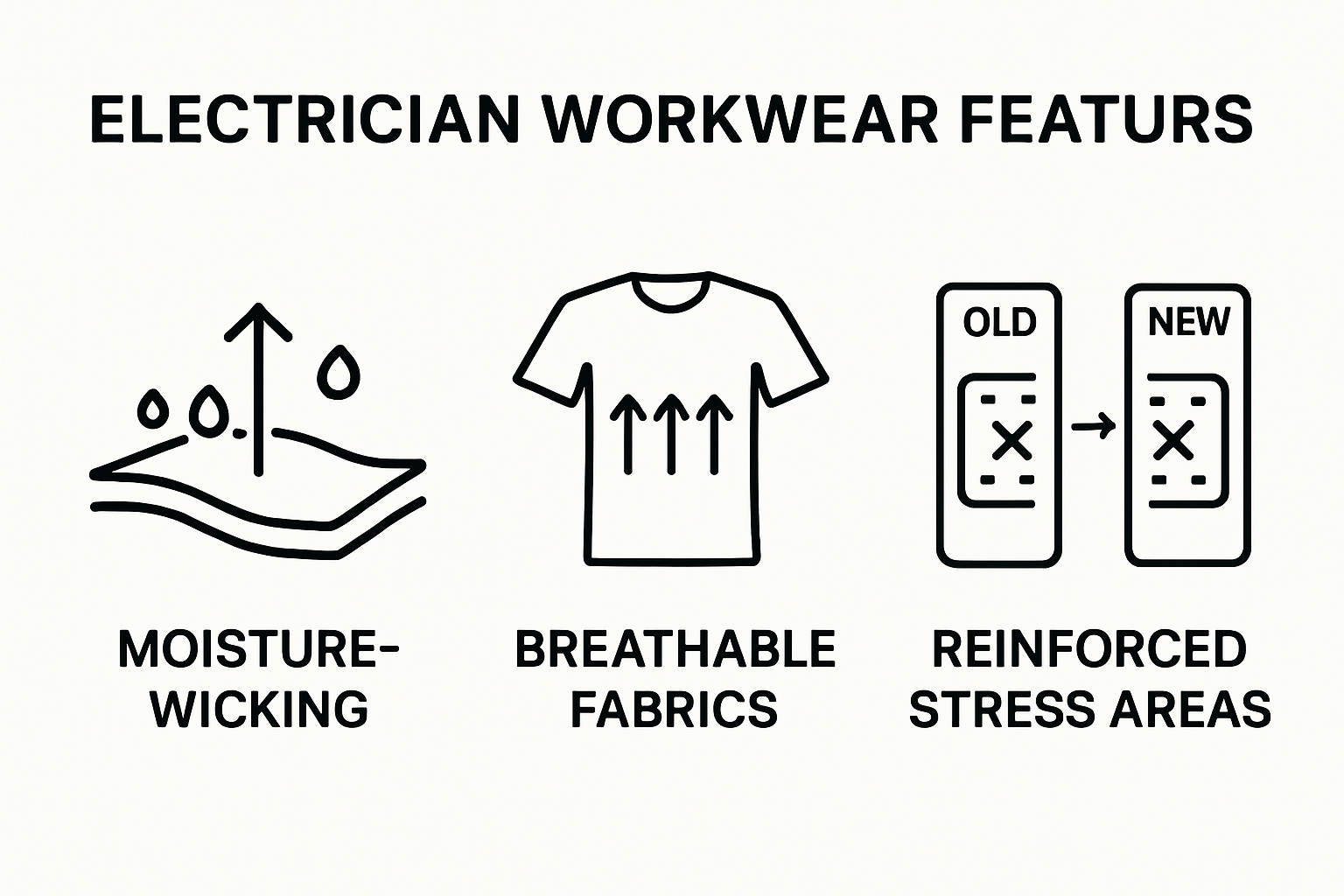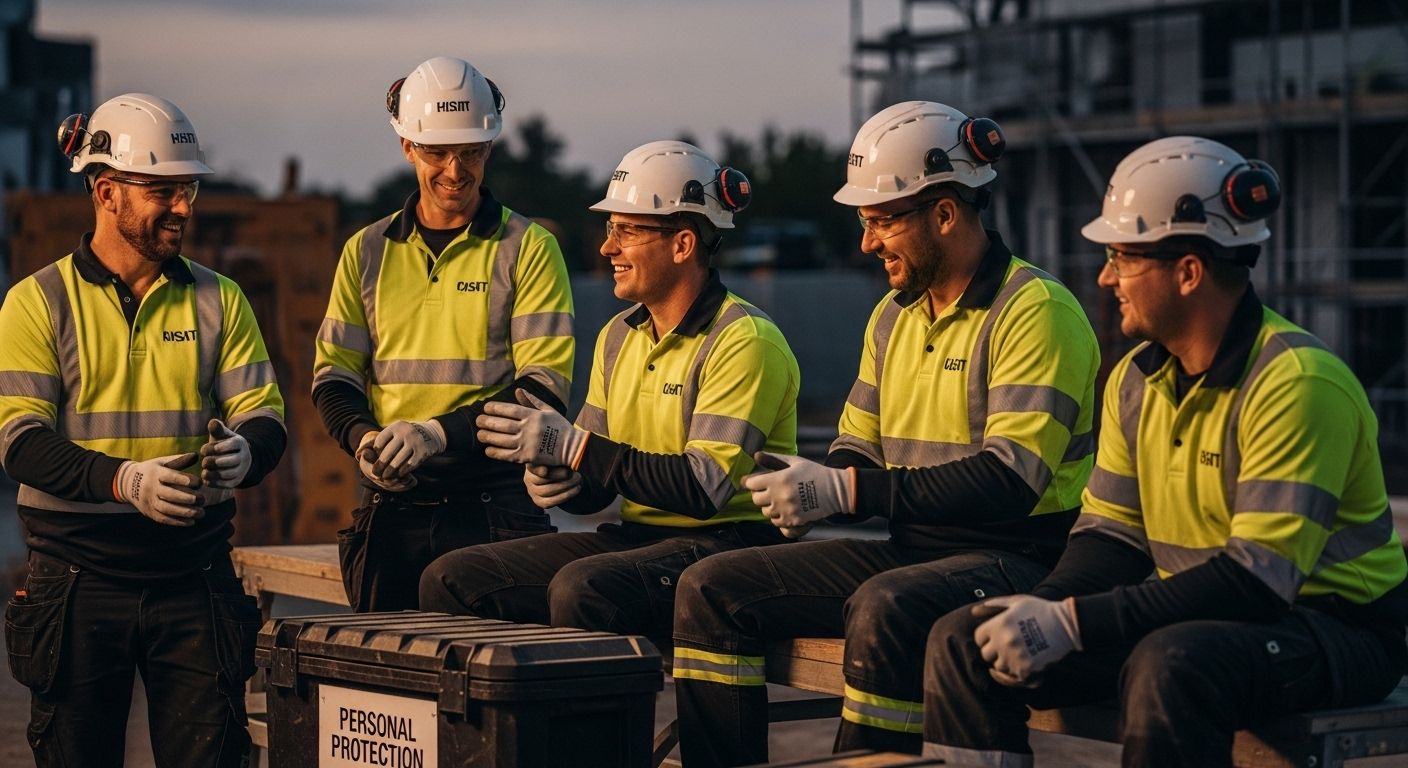
Electricians put themselves on the line every day, working in environments where safety can never be an afterthought. Most people think any durable work shirt and jeans are enough for the job. But the reality is, OSHA actually requires flame-resistant clothing and strict protective standards to guard against instant, life-changing accidents. The wild part? The best workwear for electricians in 2025 is now engineered with technology that does far more than protect—it redefines how comfort, mobility, and toughness come together, changing what it means to be safe on the job.
Table of Contents
- Key Features Of Quality Electrician Workwear
- Safety Standards And Protective Fabrics Explained
- Top Workwear Brands For Electricians In 2025
- Choosing The Right Gear For Every Job And Season
Quick Summary
| Takeaway | Explanation |
|---|---|
| Select flame-resistant materials for workwear. | Flame-resistant fabrics are essential to protect electricians from electrical hazards and potential burns. |
| Prioritize comfort and mobility in design. | Ergonomic features like adjustable waistbands and flexible fabrics ensure electricians can move freely without sacrificing safety. |
| Understand safety standards and compliance. | Familiarize yourself with OSHA and NFPA regulations to ensure your workwear meets essential safety requirements. |
| Adapt workwear for seasonal tasks. | Choose workwear layers suitable for different environmental conditions to maintain comfort and safety year-round. |
| Evaluate brands for safety features and durability. | Look for reputable brands that comply with safety standards and offer innovative protective technologies for comprehensive defense. |
Key Features of Quality Electrician Workwear
Electricians face unique workplace challenges that demand specialized workwear designed for maximum safety and performance. The right clothing isn’t just about comfort it’s a critical layer of protection against electrical hazards, environmental conditions, and potential workplace accidents.
Safety-First Material Design
Quality electrician workwear starts with materials engineered for protection. According to the Occupational Safety and Health Administration (OSHA), electrical workers require clothing that provides comprehensive protection against electrical risks. Flame-resistant fabrics are non-negotiable, with materials like aramid fibers and treated cotton offering superior arc flash protection.
Electrical Hazard Resistance: The clothing must withstand electrical challenges. This means using non-conductive materials that prevent electrical current transmission and minimize potential injury risks. Specialized workwear incorporates layers that create barriers against potential electrical incidents, ensuring workers remain protected during complex electrical tasks.
Advanced Performance Features
The National Fire Protection Association’s NFPA 70E standard emphasizes the importance of comprehensive protection for electrical workers. Modern electrician workwear goes beyond basic safety, integrating performance-enhancing features that support professionals throughout demanding workdays.
Key performance elements include:
- Moisture-Wicking Technology: Fabrics that quickly draw sweat away from the body, maintaining worker comfort during intensive electrical work
- Breathable Fabric Constructions: Materials that allow air circulation, preventing overheating in challenging work environments
- Reinforced Critical Areas: Extra durability in high-stress zones like knees, elbows, and pockets to withstand daily wear and tear

Ergonomic Design and Functionality
Research from the National Institute for Occupational Safety and Health (NIOSH) highlights the importance of clothing that supports worker mobility and comfort. Electrician workwear must provide unrestricted movement while maintaining protective capabilities.
Ergonomic considerations include strategic pocket placements, flexible fabric blends, and articulated joints that allow full range of motion. Adjustable waistbands, reinforced stress points, and lightweight materials ensure electricians can perform intricate tasks without clothing becoming a hindrance.
Choosing the right workwear is more than a fashion decision it’s a critical safety investment. Quality electrician workwear combines advanced materials, performance technologies, and thoughtful design to create a comprehensive protective system. Check out our comprehensive guide on understanding workwear essentials to dive deeper into selecting the perfect professional attire for demanding trades.
Remember: In electrical work, your clothing is your first line of defense. Prioritize safety, performance, and comfort when making your selection.
Here is a table summarizing the key features of quality electrician workwear, organizing safety, performance, and ergonomic elements to help you evaluate and compare options:
| Feature Category | Key Elements | Benefits for Electricians |
|---|---|---|
| Safety-First Material Design | - Flame-resistant fabrics (aramid, treated cotton) | Protects against electrical and fire risks |
| - Non-conductive materials | Minimizes injury from electrical current | |
| Advanced Performance | - Moisture-wicking technology - Breathable fabrics - Reinforced zones |
Keeps workers dry, cool, and comfortable; increases durability |
| Ergonomic Design | - Strategic pockets - Flexible blends - Articulated joints - Adjustable waistbands |
Enhances mobility and comfort for intricate tasks |
Safety Standards and Protective Fabrics Explained
Electrical work demands a rigorous approach to personal protective equipment (PPE), with safety standards serving as the critical foundation for worker protection. Understanding these standards and the science behind protective fabrics is essential for electricians who face significant workplace hazards.
OSHA and NFPA Regulatory Framework
According to the Occupational Safety and Health Administration (OSHA), electrical workers must adhere to strict clothing regulations designed to minimize injury risks. The standard 1910.269(l)(6) explicitly prohibits wearing clothing that could potentially ignite and continue burning during electrical incidents.
Key Regulatory Requirements:
- Mandatory use of flame-resistant (FR) clothing
- Prohibition of easily combustible materials like acetate, nylon, and polyester
- Comprehensive training on electrical arc hazards and appropriate protective gear
The National Fire Protection Association’s NFPA 70E standard further refines these requirements by establishing specific hazard risk categories and corresponding PPE recommendations. This framework ensures electricians have clear guidelines for selecting appropriate protective clothing based on potential workplace risks.
Advanced Protective Fabric Technologies
Research from North Carolina State University’s Environmental Health and Safety department highlights the sophisticated engineering behind modern protective fabrics. Advanced materials are specifically designed to provide multiple layers of protection against electrical hazards.
Critical fabric characteristics include:
- Arc-Rated Protection: Materials engineered to withstand specific levels of incident energy
- Thermal Resistance: Fabrics that prevent heat transfer and minimize burn risks
- Electrical Insulation: Non-conductive materials that reduce electrical current transmission
Comprehensive Personal Protection Strategy
Protective workwear extends beyond mere fabric selection. A holistic approach involves understanding the entire protective ecosystem. This means considering not just the outer layer, but also undergarments, accessories, and overall clothing system.
Professional electricians must pay attention to:
- Natural fiber undergarments to prevent melting
- Nonconductive safety glasses and eye protection
- Layered clothing systems that provide maximum mobility and protection
Choosing the right protective workwear is a complex decision that requires understanding technical specifications, regulatory requirements, and personal comfort. Learn more about selecting the right professional workwear to ensure comprehensive safety and performance.
Remember: In electrical work, your protective clothing is not just an outfit it’s a critical safety system designed to preserve your life and well-being.
To clarify the main regulatory requirements and protective fabric attributes for electricians, the table below summarizes OSHA and NFPA safety standards and essential fabric technologies:
| Standard/Requirement | Key Points | Application for Electricians |
|---|---|---|
| OSHA 1910.269(l)(6) | - Mandatory flame-resistant clothing - Ban on flammable synthetics - Arc hazard training |
Basic compliance for all electrical work |
| NFPA 70E | - Hazard risk categories - PPE recommendations |
Guides clothing & PPE selection |
| Protective Fabric Technologies | - Arc-rated protection - Thermal resistance - Electrical insulation |
Minimizes burn and shock injury |
Top Workwear Brands for Electricians in 2025
Electricians require specialized workwear that combines durability, safety, and performance. In 2025, several brands have distinguished themselves by meeting the rigorous demands of electrical professionals, offering innovative solutions that prioritize worker protection and comfort.
Industry-Leading Workwear Manufacturers
According to industry research, brands like Red Kap have been providing reliable workwear solutions for decades. Established in 1923, this company represents the gold standard in professional work clothing, understanding the unique challenges faced by tradespeople.
Brand Evaluation Criteria:
- Compliance with safety standards
- Durability of materials
- Innovative protective technologies
- Comfort and mobility features
- Range of sizing options
Dickies, another renowned manufacturer, has been a consistent performer in the workwear market since 1922. Their long-standing reputation stems from creating clothing that withstands demanding work environments while providing essential protection for electrical professionals.
Advanced Protection and Technology Integration
Portwest, a global clothing manufacturer, has made significant strides in developing high-performance workwear specifically designed for electricians. Their product lines incorporate cutting-edge protective technologies that address multiple workplace safety concerns.
Key technological innovations include:
- Flame-resistant fabric developments
- Enhanced electrical arc protection
- Moisture-wicking materials
- Lightweight yet durable construction
- Ergonomic design elements
Comprehensive Workwear Selection Strategy
Selecting the right workwear brand involves more than just picking a popular name. Electricians must consider multiple factors that directly impact their safety and performance. This means evaluating brands based on their commitment to worker protection, technological innovation, and understanding of trade-specific challenges.
Professional considerations include:
- Certification and safety standard compliance
- Price point and long-term value
- Specific protective features
- Comfort and range of motion
- Adaptability to various work environments
Learn more about selecting professional workwear to make an informed decision that balances safety, comfort, and performance.
Remember: Your workwear is more than clothing. It’s a critical tool that protects your most valuable asset you. Choose wisely, invest in quality, and prioritize brands that demonstrate a genuine commitment to worker safety and professional excellence.
Choosing the Right Gear for Every Job and Season
Electricians face diverse work environments that demand adaptive and strategic clothing choices. Selecting the right workwear involves understanding the nuanced requirements of different job sites, seasonal challenges, and specific electrical tasks.
Seasonal Workwear Adaptability
According to the U.S. Department of Labor’s Occupational Safety and Health Administration (OSHA), personal protective equipment must properly fit each worker and adapt to changing environmental conditions. This means electricians need a versatile wardrobe that provides comprehensive protection across temperature ranges and work scenarios.
Seasonal Protection Strategies:
- Summer: Lightweight, breathable FR materials with moisture-wicking properties
- Winter: Layered clothing systems with thermal insulation
- Transitional seasons: Adaptable garments with removable liners
- Humidity control: Fabrics that manage sweat and maintain comfort
North Carolina State University’s Environmental Health and Safety department emphasizes the importance of selecting clothing that provides comprehensive protection while maintaining worker mobility and comfort.
Job-Specific Protective Requirements
Electrical work encompasses diverse environments from indoor installations to outdoor infrastructure maintenance. Each job demands specific protective considerations beyond standard safety gear.
Key job-specific considerations include:
- Indoor Electrical Work: Lightweight, flexible FR clothing with enhanced mobility
- Outdoor Infrastructure Projects: Multilayer protection with weather-resistant features
- High-Voltage Installations: Maximum arc-rated protection with additional insulation
- Confined Space Work: Slim-fit designs that allow unrestricted movement
Comprehensive Personal Protection Assessment
The National Fire Protection Association’s NFPA 70E standard provides critical guidance for selecting protective gear that matches specific workplace hazards. Electricians must evaluate their workwear through a holistic lens that considers multiple protective factors.
Comprehensive protection assessment involves:
- Incident energy level analysis
- Work environment temperature ranges
- Potential mechanical stress on clothing
- Required mobility and comfort levels
- Specific electrical hazard categories
Professional electricians understand that workwear is more than clothing it’s a critical safety system designed to protect against multiple potential risks. Learn more about professional workwear selection strategies to make informed decisions that prioritize your safety and performance.
Remember: Your workwear is your first line of defense. Choose wisely, invest in quality, and never compromise on protection.

Frequently Asked Questions
What are the key features to look for in electrician workwear?
Quality electrician workwear should include flame-resistant materials, ergonomic designs for mobility, advanced performance features like moisture-wicking technology, and reinforced areas for durability against wear and tear.
Why are flame-resistant materials important for electricians?
Flame-resistant materials are critical for electricians as they provide essential protection against electrical hazards and potential burns, complying with OSHA safety regulations to minimize injury risks during work.
How can I ensure my workwear adapts to different seasons?
To ensure adaptability for seasonal changes, choose workwear made from lightweight, breathable fabrics for summer, layered clothing systems with thermal insulation for winter, and versatile garments with removable liners for transitional seasons.
What regulatory standards apply to electrician workwear?
Electrician workwear must comply with OSHA standards, which mandate the use of flame-resistant clothing and prohibit easily combustible materials. Additionally, NFPA 70E outlines specific hazard risk categories and corresponding PPE requirements.
Step Up Your Safety and Comfort With Workwear Built for Electricians
You work hard, and your gear should do the same. If you are searching for clothing that protects against electrical hazards and stands up to real jobsite challenges, you deserve more than the basics. At WorkWear Comfort, we supply purpose-built apparel for electricians tackling tough jobs in 2025. That means flame-resistant fabrics, smart moisture-wicking designs, and features that allow true freedom of movement. Discover options like our UPF 50+ Sun Protection Hoodie, made for those who are out in changing conditions or put in long shifts on exposed sites.

Don’t compromise on safety or comfort. Visit WorkWear Comfort today and find the gear that keeps you protected on the job, season after season. Shop now and experience occupational clothing designed for your trade and your values. Your next shift could be safer, more comfortable, and more confident—make that upgrade now.


